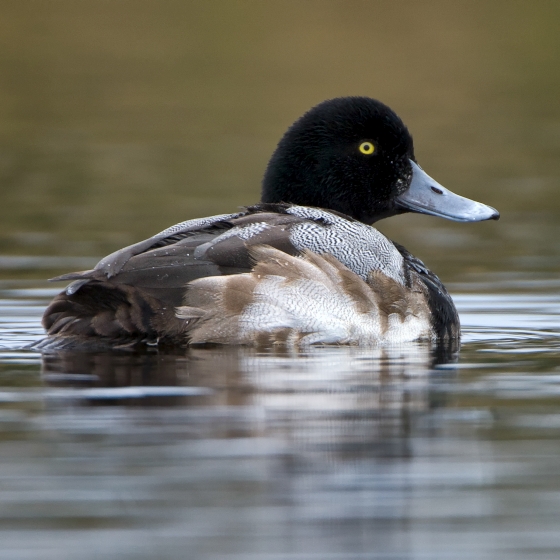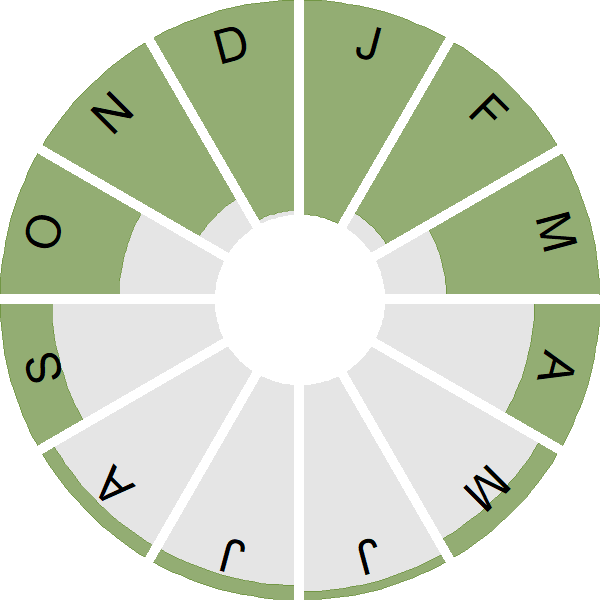Scaup

Introduction
This black and white diving duck is a winter visitor to the loughs, lochs and shallow inshore waters of the UK.
Scaup begin arriving in Britain & Ireland during the second half of October from breeding grounds in Iceland, Scandinavia and western Russia. Numbers continue to build throughout the winter months and, as might be expected, birds from the western part of their range largely occur in western Britain and those from the east in eastern Britain.
The Wetland Bird Survey shows that around 3,000 Scaup winter in the UK with the largest gatherings found in Northern Ireland and Scotland. Individuals begin to head back to their breeding grounds in March. Breeding occurs in the UK only sporadically, only involving one or two pairs in any given year.

Key Stats
Identification
ID Videos
This section features BTO training videos headlining this species, or featuring it as a potential confusion species.
Diving Ducks
Status and Trends
Conservation Status
Population Size
Population Change
Scaup are a winter visitor to the UK, with the majority found in Northern Ireland and Scotland. They are predominantly a marine species, however they are occasionally found on inland waters, in particular, Loughs Neagh and Beg in Northern Ireland, which is now the key site for this species. WeBS data show that the species increased in numbers from the late 1970s until the mid-2000s, since when it has declined sharply with numbers now lower than they were in the 1970s.
Distribution
Scaup occupy a wide range of coastal and inland areas, though the greatest numbers are found on the coast in northern and western Britain and northeastern and southwestern Ireland.
Occupied 10-km squares in UK
2007/08–10/11
or view it on Bird Atlas Mapstore.
2008–11
or view it on Bird Atlas Mapstore.
European Distribution Map
Distribution Change
Scaup winter range has exanded by 57% since the 1981–84 Winter Atlas with gains in some coastal areas, including the Northern Isles, Moray Firth and southwest England, and also at inland sites. This contrasts with a marked population reduction, especially in Ireland.
Change in occupied 10-km squares in the UK
from 1981–84 to 2007–11
or view it on Bird Atlas Mapstore.
from 1968–72 to 2008–11
or view it on Bird Atlas Mapstore.
Seasonality
Scaup is a localised winter visitor, present from September to March, though some birds occasionally summer.
Weekly pattern of occurrence
The graph shows when the species is present in the UK, with taller bars indicating a higher likelihood of encountering the species in appropriate regions and habitats.

Movement
Britain & Ireland movement
Foreign locations of birds ringed or recovered in Britain & Ireland
Dots show the foreign destinations of birds ringed in Britain & Ireland, and the origins of birds ringed overseas that were subsequently recaptured, resighted or found dead in Britain & Ireland. Dot colours indicate the time of year that the species was present at the location.
- Winter (Nov-Feb)
- Spring (Mar-Apr)
- Summer (May-Jul)
- Autumn (Aug-Oct)

European movements
EuroBirdPortal uses birdwatcher's records, such as those logged in BirdTrack to map the flows of birds as they arrive and depart Europe. See maps for this species here.
The Eurasian-African Migration Atlas shows movements of individual birds ringed or recovered in Europe. See maps for this species here.
Biology
Productivity and Nesting
Nesting timing
Egg measurements
Clutch Size
Survival and Longevity
Survival is shown as the proportion of birds surviving from one year to the next and is derived from bird ringing data. It can also be used to estimate how long birds typically live.
View number ringed each year in the Online Ringing Report.
Lifespan
Survival of adults
Biometrics
Wing length and body weights are from live birds (source).
Ring Size
Classification, names and codes
Classification and Codes
- Order: Anseriformes
- Family: Anatidae
- Scientific name: Aythya marila
- Authority: Linnaeus, 1761
- BTO 2-letter code: SP
- BTO 5-letter code: SCAUP
- Euring code number: 2040
Alternate species names
- Catalan: morell buixot
- Czech: polák kaholka
- Danish: Bjergand
- Dutch: Topper
- Estonian: merivart
- Finnish: lapasotka
- French: Fuligule milouinan
- Gaelic: Lach-mhara
- German: Bergente
- Hungarian: hegyi réce
- Icelandic: Duggönd
- Irish: Lacha Iascán
- Italian: Moretta grigia
- Latvian: kerra
- Lithuanian: žiloji antis
- Norwegian: Bergand
- Polish: ogorzalka (zwyczajna)
- Portuguese: negrelho
- Slovak: chochlacka morská
- Slovenian: rjavka
- Spanish: Porrón bastardo
- Swedish: bergand
- Welsh: Hwyaden Benddu
- English folkname(s): Mussel/Norwegian Duck
Research
Causes of Change and Solutions
Causes of change
Count data from across northwest Europe show a 38% decline in wintering numbers of Scaup between the late 1980s and the late 2010s, as well as a distribution shift towards the east and north with numbers increasing in Germany, Poland, Sweden and Estonia [Marchowski et al. 2020]. The species faces threats from reductions in food supplies and lack of effective implementation of conservation measures to protect them from the impacts of bycatch [Marchowski et al. 2019, 2020].
More Evidence
More evidence from Conservation Evidence.com
Partners
Citing BirdFacts
If you wish to cite particular content in this page (e.g. a specific value) it is best to use the original sources as linked in the page. For a more general citation of the whole page please use: BTO (20XX) BirdFacts Species: profiles of birds occurring in the United Kingdom. BTO, Thetford (www.bto.org/birdfacts, accessed on xx/xx/xxxx).

